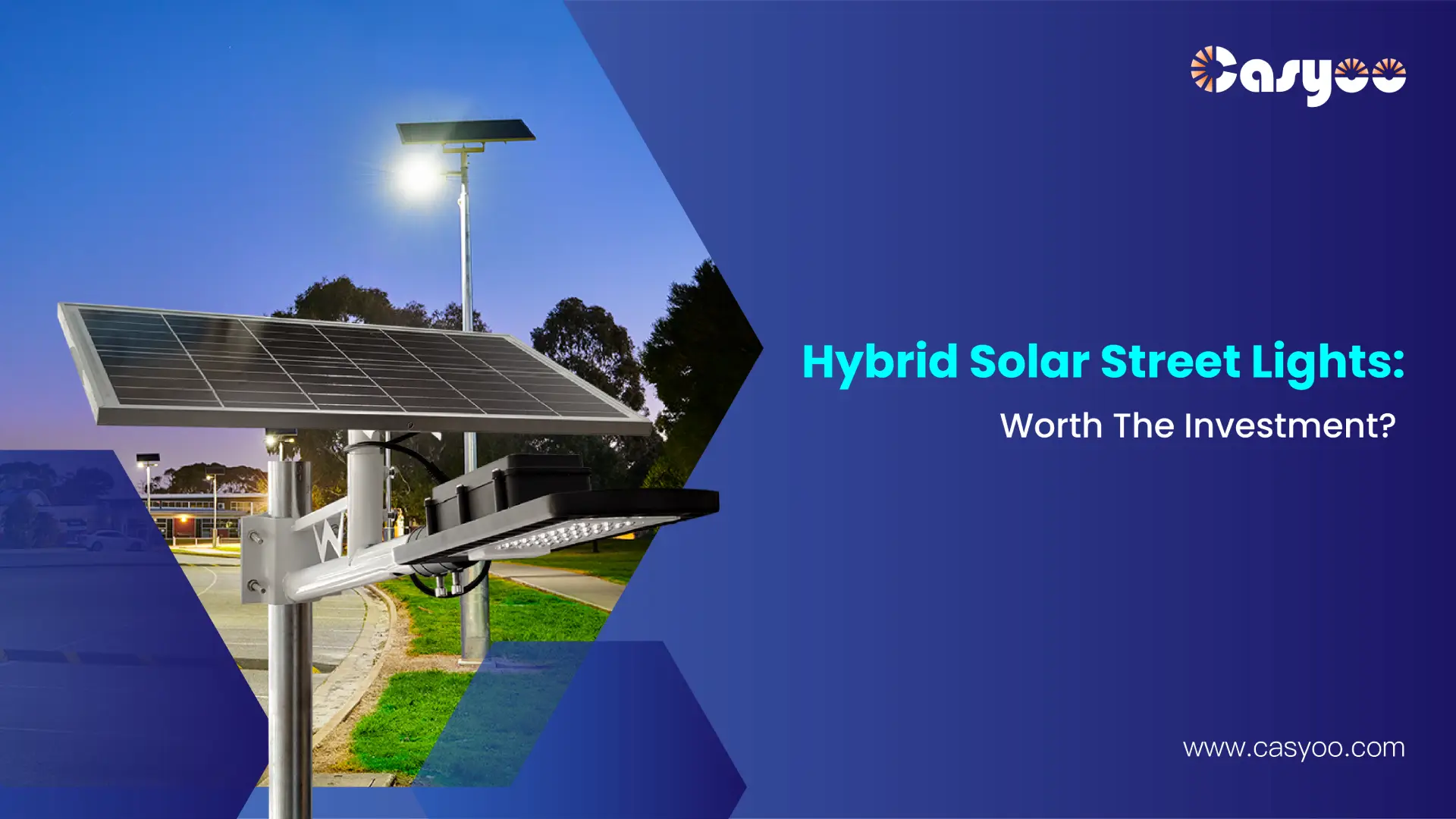Urban lighting has seen a revolutionary change in recent years. Through a precise combination of solar technology and grid power, experts developed street lighting that reduce energy expenditures and provide near-perfect reliability. These days, this hybrid technology saves a lot of energy while enabling towns to keep their lights on continuously, even during weeks of cloudy weather.
This tutorial will show you how this smart power management innovation is changing urban lighting and why it is important for the future of your city.
Understanding Hybrid Solar Street Lights
The Power of Dual Energy Sources
Fundamentally, a hybrid solar street light integrates the advantages of both conventional power grid and solar energy. In contrast to traditional street lights that only use energy from the grid or pure solar lights that only use sunshine, hybrid systems intelligently alternate between different power sources to guarantee continuous illumination.
Comparing Lighting Technologies
Although they have been useful to cities, traditional street lights have many disadvantages. They need a lot of wiring infrastructure, use a lot of electricity, and have limited operational flexibility. Even while pure solar street lights are better for the environment, they may not work well in areas with little sunlight or during prolonged bad weather.
The Hybrid Advantage
This gap is perfectly filled by hybrid solar street lights. During the day, they use solar energy, and as a backup, they keep a steady link to the grid. No matter the weather or the amount of solar energy available, our dual-power strategy guarantees that your streets will never go dark.
Core Components and Technical Excellence
An important advancement in street lighting technology is represented by hybrid solar street lights. In contrast to pure solar lights with simple panels and batteries or standard street lights with just a light fixture and power connection, hybrid systems use extra parts to produce a more dependable and effective lighting solution.
The Foundation: Core Components
Although the basic components of hybrid solar street lights are similar to those of pure solar street lights, the demands of the hybrid system usually lead to greater standards for these components. To accommodate various conditions, the LED modules in these systems have color temperatures ranging from 3000K to 5000K and an efficiency of 160 lumens per watt. Over a rated lifespan of 100,000 hours, this performance is maintained with the aid of advanced heat management.
Monocrystalline silicon panels with an energy conversion efficiency of 21% are used in the solar power system. For long-term outdoor performance, these panels’ tempered glass protection and anti-reflective coating are crucial. Depending on the location, the angle of these panels can be adjusted during installation to improve solar energy collecting.
Because of its stability and durability, lithium phosphate batteries are used in the energy storage system. These batteries can withstand temperatures ranging from -20°C to 60°C and run effectively for more than 2000 cycles while retaining 80% of their capacity. The dependability of the hybrid system across a range of weather circumstances depends on this strong performance.
The Game-Changer: Intelligent Control System
The advanced control system of hybrid systems is what really makes them unique. This special part acts as the “brain” of the system, continuously checking the amount of power coming from the grid and solar sources. The controller optimizes energy use while guaranteeing continuous lighting by automatically switching between power sources based on current conditions. Traditional or pure solar street lights completely lack this clever management method.
Grid Connection with a Twist
The sophisticated grid connecting mechanism is another noteworthy aspect. Intelligent backup power integration is a feature of hybrid systems, in contrast to the straightforward power connection of conventional street lights or the total lack of grid connection in pure solar lights. The system’s smart metering features and automatic transfer switches allow for smooth power transitions and dependable operation in all weather.
Weather Monitoring and Communication
Other street lighting options do not have the monitoring and communication features that hybrid systems do. While integrated connectivity allows for remote management and monitoring, sophisticated sensors monitor system performance and environmental conditions. Simpler lighting solutions lack the capabilities that this advanced monitoring system provides, such as performance optimization and maintenance requirement prediction.
System Integration Excellence
The way these parts function together is where hybrid solar street lights really shine. Whereas conventional lights only serve as grid-connected fixtures and pure solar lights run independently, hybrid solutions build an intelligent network that adjusts to the energy supply and environmental conditions. The integrated system differs from both conventional and pure solar options in that it can forecast energy requirements, adjust to seasonal variations, and maintain peak performance through advanced power management.
Why Choose Hybrid Solar Street Lights?
Superior Reliability
The unparalleled dependability of hybrid solar street lights is its distinguishing feature. Through clever power source switching, hybrid solutions guarantee continuous illumination, in contrast to pure solar systems that could malfunction during protracted bad weather. The technology smoothly switches to grid power when solar battery levels fall below ideal thresholds, removing the possibility of illumination outages in cloudy weather.
This reliability advantage becomes particularly crucial for applications such as:
- Consistent illumination has a direct impact on public safety in busy urban environments.
- Locations that are sensitive to security and cannot withstand disruptions in lighting
- Areas that regularly endure protracted periods of unfavorable weather
- Zones of critical infrastructure that must have constant lighting
Intelligent Adaptation
The adaptive intelligence of hybrid systems is what really makes them unique. To choose the best power source, the smart control system continuously evaluates a number of factors, including battery levels, the weather, past consumption trends, and current energy pricing. The system may run nearly exclusively on solar energy in the summer and intelligently switch between solar and grid electricity in the winter.
This adaptability also applies to light output. Depending on traffic patterns, ambient light levels, or certain time-based needs, the system can modify brightness. To further optimize energy use without sacrificing safety, major highways might, for instance, automatically dim to 60% during periods of low traffic while maintaining full brightness during peak hours.
Optimized Environmental Impact
Although hybrid and pure solar systems both lower carbon emissions, hybrid solutions do it in a more complex manner. These systems maximize their solar energy use and limit grid power consumption to necessary times exclusively through sophisticated energy management. Compared to large-scale pure solar installations, the lesser battery and solar panel requirements also lessen the environmental impact of manufacturing.
The reliability of the power network as a whole is enhanced by the incorporation of hybrid systems into the smart grid. By prioritizing battery power during moments of high grid demand, these lights can lessen the burden on the electrical system. Beyond only saving electricity, this grid-friendly activity has other environmental benefits.
Cost Benefits
The 15–25% greater initial cost of hybrid solar street lights may seem hefty at first. Long-term economics, however, paints a different picture.
In the same way that a hybrid car maximizes its two power sources, these systems employ lesser components more efficiently through intelligent management. Recent studies have shown that they can save up to 45% on energy costs when compared to conventional street lighting, in part by employing techniques like lowering power to 70% during off-peak hours.
Maintenance is the game-changer. These technologies can double battery life to 10.5 years by maintaining appropriate battery discharge levels. In addition to anticipated equipment cost reductions, payback durations for urban installations may decrease from 18 to 6-7 years.
This calculation, however, performs better in cities with pre-existing grid infrastructure. Pure solar may still be more cost-effective for isolated areas requiring new grid connections, unless dependability is an absolute need. The secret is to adapt the technology to your own requirements and circumstances.
For urban lighting, where dependability is crucial, hybrid systems frequently turn out to be the more economical option when considering the big picture, which includes lower maintenance requirements, longer component life, and lower energy costs.
Real World Success Stories
Through successful real-world installations, hybrid solar street lighting are demonstrating their worth. An excellent illustration is seen in Veldhoven, Netherlands, where the roundabouts along the Zilverbaan are illuminated by a cutting-edge energy-neutral lighting system. Ten-meter-tall smart poles with two LED lights are part of the installation; they serve the main road and the bike path and store energy in strategically positioned lithium batteries.
The energy management of the system is where the real innovation is found. Excess solar energy is fed back into the grid in the summer, while during prolonged overcast spells in the winter, the system consumes grid power. This well-balanced strategy maintains net-zero energy consumption while guaranteeing constant illumination. The Veldhoven project’s success shows how hybrid systems can successfully blend sustainability objectives with dependable performance, which is why they are becoming more and more common for urban lighting applications globally.

Frequently Asked Questions
- How difficult is it to install street lights powered by hybrid solar?
For skilled personnel, the installation procedure is simple. The majority of the parts for hybrid systems are pre-assembled, even though they have more parts than conventional street lights. Foundation preparation, pole mounting, solar panel alignment, and grid connection are the primary installation procedures. With a skilled crew, a typical installation takes one working day.
- How often should hybrid solar street lighting be maintained?
Because of the system’s intelligent monitoring capabilities, less maintenance is needed. Regular visual inspections and occasional cleaning of the solar panels—the frequency of which varies depending on the local dust conditions—are the primary maintenance duties. Any performance problems are automatically reported by the smart control system, enabling preventative maintenance as opposed to reactive repairs.
- What occurs when the electricity grid fails?
Hybrid solar street lighting instantly transition to solar-powered batteries during blackouts. Continuous illumination is ensured by the smooth transition managed by the intelligent management system. The system immediately switches back to its ideal power-source balancing mode when grid power is restored. One of the main benefits over both conventional grid-powered and entirely solar street lights is this redundancy.
Making the Smart Choice
Because they combine intelligent power management with guaranteed reliability, hybrid solar street lights stand out as communities throughout the world look for sustainable lighting options. Successful projects like Veldhoven’s energy-neutral installation show how these technologies may adapt to local conditions while maintaining consistent performance in both metropolitan infrastructure and distant locales.
Our LED luminaires offer seamless compatibility and excellent performance because they are specifically made for hybrid solar street light systems. To discuss your project requirements and receive a comprehensive smart lighting solution, get in touch with our staff right now.




